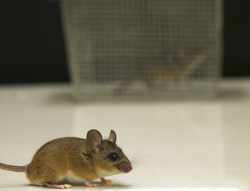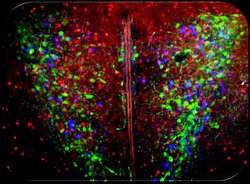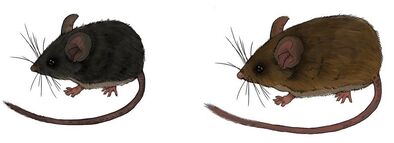Current Research Interests

New NIH policies encourage basic research programs to consider sex as a biological variable (SABV) and include both males and females in experiments. Our research with California mice provides an outlet for testing hypotheses in females that are developed with transgenic mice. We are very interested in collaborating with labs seeking to test hypotheses in females. A genome and online brain atlas (brainmaps.org) are available for California mice. See the main page or contact Brian Trainor for more information.
Complementary neural circuits of social approach and vigilance

Oxytocin is a well-known modulator of social behaviors and has been put forth as a possible therapeutic for anxiety and depression. In some studies using human participants, intranasal oxytocin enhances social approach related behaviors. However, other studies (especially in women) report that intranasal oxytocin increases social anxiety. How can the same neuropeptide exert such different effects on behavior? Our central hypothesis is that oxytocin acts in the mesolimbic dopamine system to promote social approach, whereas oxytocin acts in the bed nucleus of the stria terminalis (BNST) to enhance social anxiety (Steinman, Duque-Wilckens & Trainor 2019). Dr. Natalia Duque-Wilckens showed that oxytocin neurons in the BNST project to brain regions that modulate defensive behaviors (Duque-Wilckens et al. 2020). If oxytocin synthesis is inhibited in the BNST, stress-induced decreases in social approach can be largely reversed. She also showed that infusing oxytocin into the BNST of unstressed males or females can increase anxiety-related behaviors like social vigilance (avoiding a social context while simultaneously orienting toward it). In contrast, Dr. Alexia Williams showed that oxytocin receptors in nucleus accumbens promote social approach in both males and females (Williams et al. 2020). Previous work by Dr. Michael Steinman showed that social stress induces a long-term increase in reactivity of oxytocin neurons in the BNST in females but not males (Steinman et al. 2016), and we will be using RNASeq to identify molecular changes that may underlie this effect. Collaborative work with the Robison lab at Michigan State Univesity is examining the electrophysiological properties of BNST oxytocin neurons. This project is supported by an R01 from NIMH.
Effects of Adolescent Development on Stress Sensitivity
